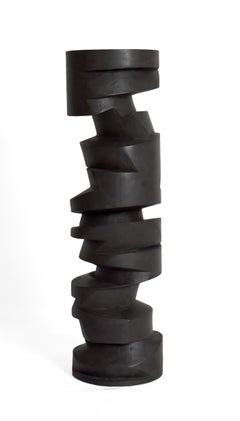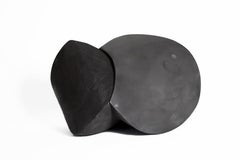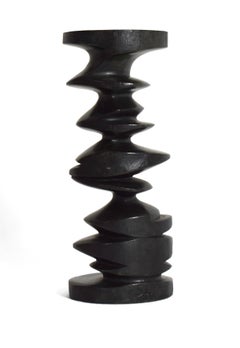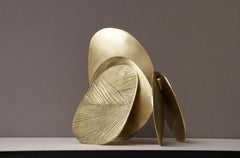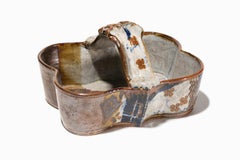Samuel Latour Art
to
4
4
Overall Height
to
Overall Width
to
4
4
4
6,886
3,210
2,514
1,217
2
2
2
Artist: Samuel Latour
Samuel Latour - Duplicité - Original Ceramic Sculpture
By Samuel Latour
Located in Collonge Bellerive, Geneve, CH
Samuel Latour - Duplicité - Original Ceramic Sculpture
32.5 x 9.5 x 9.5 cm
Edition of 8
Signed
Samuel LATOUR
Formed at Boulle arts and craft school in...
Category
2010s Modern Samuel Latour Art
Materials
Ceramic
Samuel Latour - Eclipse - Original Ceramic Sculpture
By Samuel Latour
Located in Collonge Bellerive, Geneve, CH
Samuel Latour - Eclipse - Original Ceramic Sculpture
19 x 34 x 21 cm
Edition of 8
Signed
Samuel LATOUR
Formed at Boulle arts and craft school in Pari...
Category
2010s Modern Samuel Latour Art
Materials
Ceramic
Samuel Latour - Collision n°1 - Original Bronze Sculpture
By Samuel Latour
Located in Collonge Bellerive, Geneve, CH
Samuel Latour - Collision n°1 - Original Bronze Sculpture
19 x 8 x 8 cm
Edition of 8
Signed
Samuel LATOUR
Formed at Boulle arts and craft school in Pa...
Category
2010s Modern Samuel Latour Art
Materials
Bronze
Samuel Latour - Éclat - Original Bronze Sculpture
By Samuel Latour
Located in Collonge Bellerive, Geneve, CH
Samuel Latour - Éclat - Original Bronze Sculpture
28 x 24 x 27 cm
Edition of 8
Signed
Samuel LATOUR
Formed at Boulle arts and craft school in Paris, h...
Category
2010s Modern Samuel Latour Art
Materials
Bronze
Related Items
Woman Reclined bronze sculpture by Yulla Lipchitz
Located in Hudson, NY
Organic, abstract bronze sculpture by Yulla Lipchitz of a reclined woman.
About this artist: Yulla Lipchitz, née Halberstadt, was born on April 21, 1911 in Berlin, Germany. While g...
Category
1970s Modern Samuel Latour Art
Materials
Bronze
Breathtaking John Glick "Scalloped Basket" Glazed Stoneware Reduction Fired
Located in Detroit, MI
"Scalloped Basket" is a stoneware piece with the decorative layer of the rich toned glazes and markings that John was so well-known for. He was, also, known for the undulating lip lines on his exquisite pieces. The basket portion is shaped with gentle curves and a sculptural handle. Each piece that John produced was unique. He was seduced by the effects of the reduction kiln, which decreased the levels of oxygen during firing, inducing the flame to pull oxygen out of the clay and glazes changing the colors of the glazes depending on their iron and copper content. In this way he achieved the rich gradients of ochre and umber and variations in stippling and opacity. This particular "basket" also has the cool blues and grays that contrast with the umber. It is signed and stamped on the bottom.
John was an American Abstract Expressionist ceramicist born in Detroit, MI. Though open to artistic experimentation, Glick was most influenced by the styles and aesthetics of Asian pottery—an inspiration that shows in his use of decorative patterns and glaze choices. He has said that he is attracted to simplicity, as well as complexity: my work continually reflects my re-examination that these two poles can coexist… or not, in a given series. Glick also took influences from master potters of Japan, notably Shoji Hamada and Kanjrio Kawai, blending their gestural embellishments of simple forms with attitudes of Abstract Expressionism. He was particularly drown to the work of Helen Frankenthaler whose soak-stain style resonated with Glick’s multi-layered glaze surfaces, which juxtaposed veils of atmospheric color with gestural marks and pattern. He spent countless hours developing and making his own tools in order to achieve previously unseen results in his work with clay and glaze.
Glick’s “Plum Tree Pottery...
Category
1970s American Modern Samuel Latour Art
Materials
Stoneware, Glaze
H 6 in W 11.38 in D 9 in
Bronze Flower Sculpture Plaque
By Ruth Asawa
Located in New York, NY
Ruth Asawa
Bronze Flower, 1979
Cast Bronze relief plaque with original presentation box
5 1/4 × 6 1/4 × 1/4 inches
Numbered from the Edition of 2500
Signed and dated 'Asawa 1979' (lower edge) incised in the bronze; numbered; stamped "Designed Exclusively for Crown Zellerbach Corporation"; foundry copyright
Cast at the Berkley Arts Foundry for Crown Zellerbach
Ruth Asawa's estate is represented by David Zwirner.
Unframed
This beautiful, limited edition signed cast bronze flower plaque makes a distinctive and original gift! It bears the artist's incised signature and is uniquely numbered from the limited edition of 2500. In 1979, the Crown Zellerbach Corporation of San Francisco, which had worked closely with her on neighborhood arts programs, commissioned Asawa to make a series of bronze bas-relief plaques, including this beautiful piece, which were cast by the Berkeley Arts Foundry.
Cast at Berkley Arts Foundry for Crown Zellerbach
Another example of this work was exhibited in the show "On Black Mountain: The Bauhaus Legacy in America", April 5, 2019-April 27, 2019 at the Sager Braudis Gallery in Columbia, Missouri. It is reproduced on page 13 of the exhibition catalogue.
Ruth Asawa Biography
American artist, educator, and arts activist Ruth Asawa (1926-2013) is known for her extensive body of wire sculptures that challenge conventional notions of material and form through their emphasis on lightness and transparency. Born in rural California, Asawa was first exposed to professional artists while her family and other Japanese Americans were detained at Santa Anita, California, in 1942. Following her release from an internment camp in Rohwer, Arkansas, eighteen months later, she enrolled in 1943 in Milwaukee State Teachers College. Unable to receive her degree due to continued hostility against Japanese Americans, Asawa left Milwaukee in 1946 to study at Black Mountain College in North Carolina, then known for its progressive pedagogical methods and avant-garde aesthetic environment. Asawa's time at Black Mountain proved formative in her development as an artist, and she was particularly influenced by her teachers Josef Albers, Buckminster Fuller, and the mathematician Max Dehn. She also met architectural student Albert Lanier, whom she would marry in 1949 and with whom she would raise a large family and build a career in San Francisco. Asawa continued to produce art steadily over the course of more than a half century, creating a cohesive body of sculptures and works on paper that, in their innovative use of material and form, deftly synthesizes a wide range of aesthetic preoccupations at the heart of postwar art in America.
Asawa’s work has been exhibited widely since the early 1950s, including early solo exhibitions at Peridot Gallery, New York in 1954, 1956, and 1958. In 1965, Walter Hopps organized a solo exhibition of the artist’s sculptures and drawings at the Pasadena Art Museum (now Norton Simon Museum) in California, where Asawa completed a residency at the Tamarind Lithography Workshop the same year. Other solo presentations include those held at the San Francisco Museum of Art (1973); Fresno Art Museum, California (2001; traveled to Oakland Museum of California, 2002); de Young Museum, San Francisco (2006); Amon Carter Museum of American Art, Fort Worth, Texas (2012); and Norton Simon Museum of Art, Pasadena, California (2014).
In 2018 to 2019, the Pulitzer Arts Foundation in St. Louis presented Ruth Asawa: Life’s Work, the first major museum exhibition of the artist’s work in more than a decade. An accompanying catalogue published by Pulitzer Arts Foundation and Yale University Press includes essays by Aruna D’Souza, Helen Molesworth, and Tamara H. Schenkenberg. The two-person exhibition, Lineage: Paul Klee and Ruth Asawa was on view at the San Francisco Museum of Modern Art in 2021. In 2022, Ruth Asawa: Citizen of the Universe was on view at Modern Art Oxford, England, and later traveled to the Stavanger Kunstmuseum, Norway. Opening September 16, 2023 at the Whitney Museum of American Art, New York is Ruth Asawa: Through Line, a solo presentation which will later travel to the Menil Drawing Institute in Houston.
The artist’s works have also been included in significant group exhibitions, including Leap Before You Look: Black Mountain College 1933–1957, Institute of Contemporary Art, Boston (2015; traveled to Hammer Museum, Los Angeles, and Wexner Center for the Arts, Columbus, Ohio, 2016-2017); America Is Hard to See, Whitney Museum of American Art, New York (2015); Revolution in the Making: Abstract Sculpture by Women, 1947–2016, Hauser & Wirth, Los Angeles (2017); Making Space: Women Artists and Postwar Abstraction, The Museum of Modern Art, New York (2017); The Pencil Is a Key: Drawings by Incarcerated Artists, The Drawing Center, New York (2019); and In a Cloud, in a Wall, in a Chair: Six Modernists in Mexico at Midcentury, Art Institute of Chicago (2019). A selection of the artist's work was presented at the 59th Venice Biennale, The Milk of Dreams (2022).
In addition to her wire sculptures, Asawa is well known for her public commissions, particularly in San Francisco and the wider Bay Area. These include the much beloved Andrea fountain in Ghirardelli Square (1966-1968) and the San Francisco Fountain outside the Grand Hyatt Union Square (1970-1973), the latter of which includes hundreds of baker’s clay images molded by local schoolchildren, friends, and other artists cast...
Category
Mid-20th Century Modern Samuel Latour Art
Materials
Bronze
Totem
Located in Washington, DC
Sculpture by Brazilian-born artist Elizabeth Freire. Sculpture is mounted on marble base and signed "EF". B&W photo is of Ms. Freire with renowned sculptor Etienne Martin at the Ecole Nationals des Beaux-Arts in Paris.
Elizabeth Freire is a Brazilian-born, contemporary American artist. At the age of eighteen, she left Rio de Janeiro and moved to Paris to study sculpture at l’Ecole Nationale Superieure des Beaux-Arts, receiving her Diploma there in 1979 under the direction of Claude Viseux, Etienne Martin, and Cesar. During that time she worked as an apprentice at the Fonderie de France where she learned bronze technique and she also attended etching courses at l’Ecole de Montparnasse.
In 1976, she won a commission to make three life-size figures representing the printing company, “Les Imprimeries de Boulogne,” at the International Printing Fair in Paris. She spent 1977 in Aix-en-Provence where she carved the local stone of Rogne.
Returning to Paris, the painter Lutka Pink introduced her to Otero, Frans Krajcberg and Hajdu from whom she received valuable lessons. In 1978, she traveled to Brazil where she was invited to participate in the exhibit ‘A Century of Sculpture in Brazil’. She also met with the sculptor Sergio Camargo...
Category
Early 2000s Modern Samuel Latour Art
Materials
Terracotta
Orbits ( cast bronze trays )
Located in Villafranca Di Verona, IT
Cast bronze Trays
Ø 28, 35, 47 cm
Ø 11", 13"7/8, 18"1/2 in.
Category
2010s Modern Samuel Latour Art
Materials
Bronze
1950's Organic Modern Ceramic Turquoise Abstract Sculpture / Pottery Art Vase
By Virginia Sevier Rogers
Located in Soquel, CA
Gorgeous abstract ceramic sculptural vase shaped into a unique organic yet modern form, with turquoise and earth-toned glazes that naturally blend together an catch the light at diff...
Category
Mid-20th Century Modern Samuel Latour Art
Materials
Clay, Glaze
Organic Modern Mid Century Ceramic Earthtone Pottery Art Vase
By Virginia Sevier Rogers
Located in Soquel, CA
Beautiful organically shaped mid century abstract ceramic sculptural vase that evokes water meeting earth; with a matte turquoise and deep blue glaze accentuated by textured free-for...
Category
Mid-20th Century Modern Samuel Latour Art
Materials
Clay, Glaze
Marco, Mid-Century Polish Tapestry by Zofia Butrymowicz
Located in Wilton, CT
Zofia Butrymowicz (1904-1987, Warsaw, Poland) was one in a select group of Polish textile artists who were first introduced in Chicago, USA in the 1970s by legendary dealers Anne and Jacques Baruch. Butrymowicz's body of work continues to influence the fiber art world to this day.
"New experiments in art have always been of interest to me" Butrymowicz once observed, "whether I agree with them or not, and therefore I never pass by and I am never indignant at any expression in art. I strongly believe that in the wide range of experiments there will also be some elements of the development of culture."
During the post-war period, when the countries of Eastern Europe were locked down behind the Iron Curtain, weavers there found materials in short supply. As a result, many of these artists turned to unconventional materials such as metal, paper and reeds. Zofia Butrymowicz, of Poland, recognized for innovative works in 60s and 70s, used heavy, irregular wools, barely spun at all. In 1969, she visited Canadian weaver, Mariette Rousseau-Vermette and her husband, painter and ceramicist, Claude Vermette, outside Montreal where the couple lived and worked. Zofia and Mariette had both been participants in International Tapestry Biennials in Lausane, Switzerland in the 60s and in Wall Hangings at the MoMA in New York in 1969.
Butrymowicz stayed with the Vermettes for several months, using Mariette’s looms to create tapestries that were displayed with Claude’s ceramics at a local gallery. Butrymowicz used wool from Mariette’s source. Mariette was particular about the color and intensity of her wool — she worked with technicians to perfect the spinning and dyeing so that the wool had a silky luster and dyed “more beautifully” than mechanically spun wool. The wool was a marked departure from the material Butrymowicz had access to in Poland. She “painted” her weavings with colors and shadings of yarns, including only a shimmering suggestion of a shape, often a circle, as she had done in the past, but the glisten and sumptuousness of the yarn in these works set them apart from her previous weavings.
Selected exhibitions: Central Museum of Textiles, Lodz, Poland; Museum of Contemporary Art, Chicago, Illinois; National Museum, Poznan, Poland; National Museum, Warsaw, Poland; Skopje Museum of Contemporary Art, Poland; Exempla, Munich, Germany; Museum of Modern Art, Pasadena, California; Pierre Pauli...
Category
1960s Modern Samuel Latour Art
Materials
Fabric, Textile, Tapestry, Wool
H 37 in W 34 in D 0.5 in
Morris Brose "Bronze Bull" Figurative Sculptural Abstract
Located in Detroit, MI
SALE ONE WEEK ONLY
"Bronze Bull" is an exquisite example of Morris Brose's abstract/figurative sculpture. No soft edges on this piece and no invitation to caress, the power, strength and beauty of the bronze are front and center and create awe. "Bronze Bull" is a free-standing piece signed on the base.
Morris Brose, Polish/American was born in Wyszkow, Poland. He became a sculptor and instructor of sculpture at the Detroit Institute of Arts, Wayne State University and Cranbrook Academy of Art, Bloomfield Hills, Michigan. Cranbrook was designed by architect and faculty member, Eliel Saarinen who collaborated with Charles and Ray Eames on chair and furniture design. Numerous creative artists who are alumni of Cranbrook include: Harry Bertoia, Florence Knoll, Jack Lenor Larsen, Donald Lipski...
Category
Late 20th Century Modern Samuel Latour Art
Materials
Bronze
Walking Man
By Maxine Kim Stussy 1
Located in West Hollywood, CA
Maxine Kim Stussy, a prolific sculptor and painter from the late 1940’s to present. Maxine led an incredibly artistic life traveling the world with her husband at the time, artist Ja...
Category
1970s Modern Samuel Latour Art
Materials
Bronze
Rare Brutalist Mexican Sculpture Pendant Necklace Signed Bronze Pal Kepenyes
By Pal Kepenyes
Located in Surfside, FL
Chain measures 19.5 inches in length
Pendant measures 2.4 X 1.5 X .5 inches
Pal Kepenyes is a sculptor and researcher of Hungarian art, whose artistic production includes sculptures of small and medium format, jewelry and miniature decorative pieces, all made by hand, without any machinery.
Wearable art. Sculptural pendant on matching chain cast in polished bronze or brass. Reminiscent of Harry Bertoia. Organic Modernism. Mod, space age, handmade artisan, studio jewelry.
Pal Kepenyes, wearable art pioneer. sculptor, goldsmith, jeweler, artist, was born in 1926 in Hungary. His creative talent, specifically in creating sculpted works, was evident early on. He moved to Budapest, where he first studied at the University of Arts and Crafts and later at the Academy of Fine Arts. His professor, Beni Ferenczy was one of Hungary's most influential sculptors. Pal Kepenyes (20/21st century) is active/lives in Hungary, Mexico. Pal Kepenyes is known for sculpture, jewelry making, miniature decorative pieces especially influenced by Mexican folk art and folklore. His work also includes animals, lions, tigers, fish, nude figures and milagros.
He began his studies at the School of Decorative Arts in Budapest, and then was a prisoner of war during the Stalinist regime. In 1956, at the end of the Hungarian Revolution, he finally was released and left the country for Paris, where he studied at the School of Fine Arts.
In 1956, he also traveled to Mexico, a country to which he has been devoted for the rest of his life because of his attraction pre-hispanic cultures. Along with Pedro Friedeberg, Arnold Coen, Vladimir Cora, Byron Galvez, Mathias Goeritz, Leonardo Nierman, Gabriel Orozco...
Category
1960s Modern Samuel Latour Art
Materials
Bronze
H 2.4 in W 1.5 in D 0.5 in
Cup with Patterns II (Hand-Painted, Gold Luster)
By Melanie Sherman
Located in Kansas City, MO
Melanie Sherman
Cup with Patterns II (Hand-Painted, Gold Luster)
Porcelain, Glaze, Porcelain Paint, Hand-made Vintage Decals, Gold Luster, Platinum Luster
Year: 2022
Size: 3x3.25x3.2...
Category
2010s Modern Samuel Latour Art
Materials
Luster, Porcelain, Paint, Glaze, Underglaze
Samuel Latour art for sale on 1stDibs.
Find a wide variety of authentic Samuel Latour art available for sale on 1stDibs. You can also browse by medium to find art by Samuel Latour in bronze, ceramic, metal and more. Much of the original work by this artist or collective was created during the 21st century and contemporary and is mostly associated with the modern style. Not every interior allows for large Samuel Latour art, so small editions measuring 4 inches across are available. Customers who are interested in this artist might also find the work of Curtis Jeré, Doug Johnston, and Robert De Launay. Samuel Latour art prices can differ depending upon medium, time period and other attributes. On 1stDibs, the price for these items starts at $1,563 and tops out at $6,920, while the average work can sell for $2,124.
